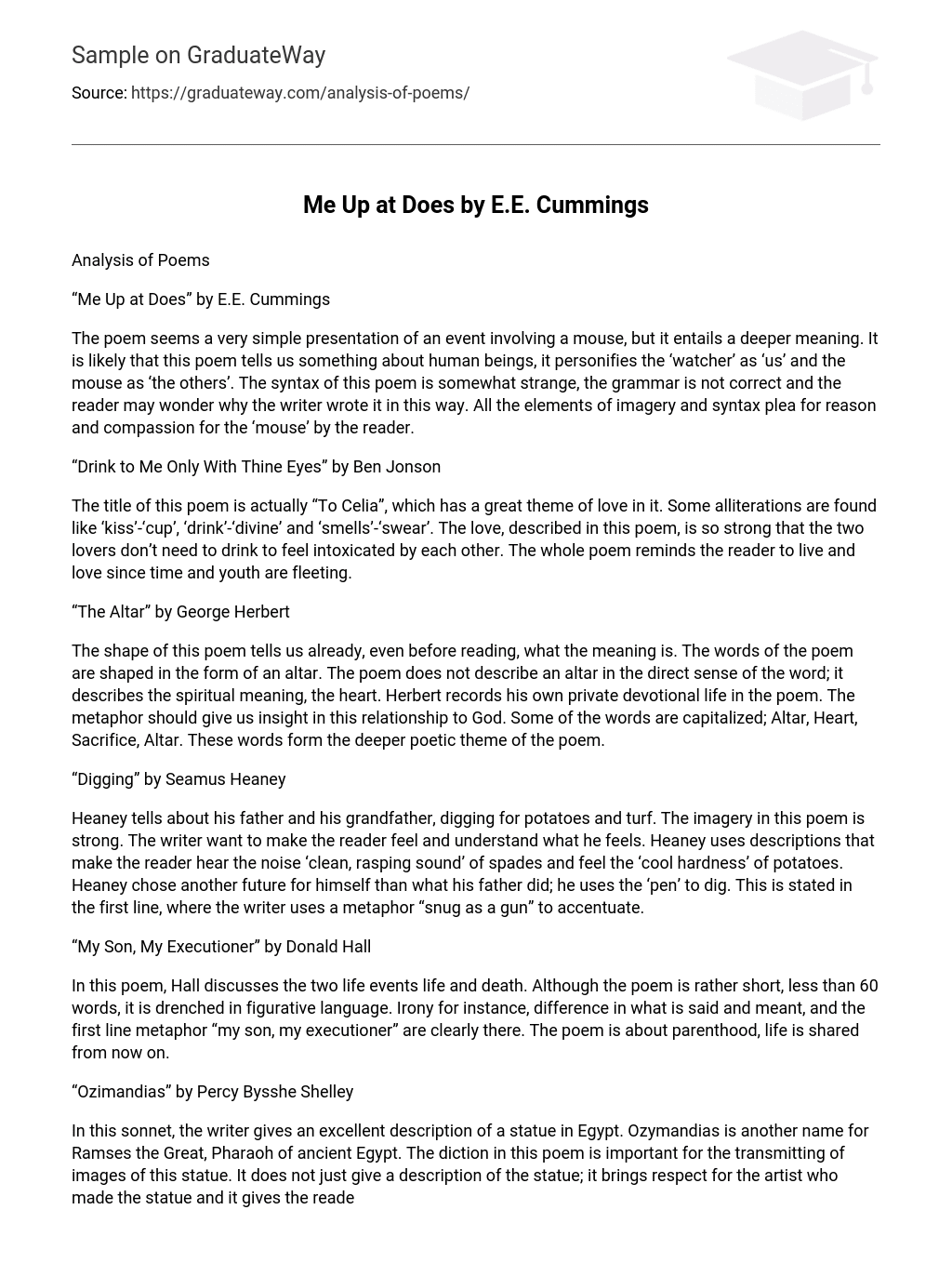Analysis of Poems
“Me Up at Does” by E.E. Cummings
The poem seems a very simple presentation of an event involving a mouse, but it entails a deeper meaning. It is likely that this poem tells us something about human beings, it personifies the ‘watcher’ as ‘us’ and the mouse as ‘the others’. The syntax of this poem is somewhat strange, the grammar is not correct and the reader may wonder why the writer wrote it in this way. All the elements of imagery and syntax plea for reason and compassion for the ‘mouse’ by the reader.
“Drink to Me Only With Thine Eyes” by Ben Jonson
The title of this poem is actually “To Celia”, which has a great theme of love in it. Some alliterations are found like ‘kiss’-‘cup’, ‘drink’-‘divine’ and ‘smells’-‘swear’. The love, described in this poem, is so strong that the two lovers don’t need to drink to feel intoxicated by each other. The whole poem reminds the reader to live and love since time and youth are fleeting.
“The Altar” by George Herbert
The shape of this poem tells us already, even before reading, what the meaning is. The words of the poem are shaped in the form of an altar. The poem does not describe an altar in the direct sense of the word; it describes the spiritual meaning, the heart. Herbert records his own private devotional life in the poem. The metaphor should give us insight in this relationship to God. Some of the words are capitalized; Altar, Heart, Sacrifice, Altar. These words form the deeper poetic theme of the poem.
“Digging” by Seamus Heaney
Heaney tells about his father and his grandfather, digging for potatoes and turf. The imagery in this poem is strong. The writer want to make the reader feel and understand what he feels. Heaney uses descriptions that make the reader hear the noise ‘clean, rasping sound’ of spades and feel the ‘cool hardness’ of potatoes. Heaney chose another future for himself than what his father did; he uses the ‘pen’ to dig. This is stated in the first line, where the writer uses a metaphor “snug as a gun” to accentuate.
“My Son, My Executioner” by Donald Hall
In this poem, Hall discusses the two life events life and death. Although the poem is rather short, less than 60 words, it is drenched in figurative language. Irony for instance, difference in what is said and meant, and the first line metaphor “my son, my executioner” are clearly there. The poem is about parenthood, life is shared from now on.
“Ozimandias” by Percy Bysshe Shelley
In this sonnet, the writer gives an excellent description of a statue in Egypt. Ozymandias is another name for Ramses the Great, Pharaoh of ancient Egypt. The diction in this poem is important for the transmitting of images of this statue. It does not just give a description of the statue; it brings respect for the artist who made the statue and it gives the reader also a great sense of the Egyptian past.
“The Word Plum” by Helen Chasin
Chasin’s use of imagery is strong in this poem. The poem gives the reader a sense of touch, taste and sensation. The used diction is therefore important here. The words and descriptions are supposed to give the reader a real feeling, even though the poem is just about a plum.
“First Fight, Then Fiddle” by Gwendolyn Brooks
This poem is a sonnet that follows the traditional rules of a sonnet. The poem is written in iambic pentameter with a series of end-stops. The first eight line talk about the lives of artists and the last six lines talk about fighting a war. At the end, Brooks gives her message about the uselessness of war. The imagery of using comparisons between a violin and civilization is outstanding. The poem gives music as a tool for preventing war and maintaining peace.
“My Mistress’ Eyes are Nothing Like the Sun” by William Shakespeare
This poem is an Elizabethan sonnet, consisting of 3 quatrains and a final couplet. Shakespeare uses a lot of comparisons and metaphors in this poem between the beautiful things in nature and a woman. But instead of portraying her in a romantic way, he does it in a realistic way, focusing on the personality.
“The Raven” by Edgar Allan Poe
This poem of Edgar Allan Poe is famous for its reoccuring line “Quoth the Raven: ‘Nevermore”. Poe uses a lot of alliterations and assonances, such as “-orrow”, in the second stanza and “weak and weary” in the first line of the poem. Also is the poem drenched with symbolism. So is the raven a symbol that brings a melancholic atmosphere and it is a symbol for despair and death. The Raven tells the story of a mysterious visit of a raven to a man (the narrator), who mournes about his lost love Lenore.
“The Game” by Judith Ortiz Cofer
The poem is about a friendship between the writer and her friend Cruz, who is physically disabled. The family of Cruz rejects her, but the narrator plays a game with her, called ‘family’. When the game ends, the unreal family goes away and sadness comes again. Cofer uses words, and therefore ‘diction’ and imagery, to let the reader know that nowadays people do not react any different than the family of Cruz. She wants us to give more appreciation to everyone in our world.
“Women” by Adrienne Rich
This poem is rather feministic, it describes three women, three sisters of the writer, being torn and hurt by men, but still busy and trying to make the best of things. The words used by Rich gives the reader sympathy for these women. The poem is written with alliterations ‘sisters-sitting’ and assonances ‘first time, in this light,’.





